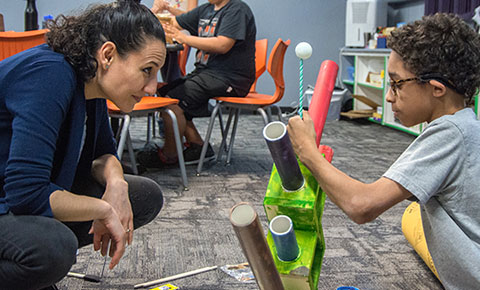Adult vs. Child-Centered Learning: Why We Need Another Path

Teachers often act as hands-off facilitators in makerspace settings, letting children lead the way. But what happens when they step back too far?
New Northwestern University research suggests that a lack of structure and guidance in learning spaces can be just as demoralizing to young people as when an adult takes complete control. The best path to educational justice, they argue, isn’t solely child- or adult-centered, but rather intergenerational.
In a new study published in the journal Cognition and Instruction, Shirin Vossoughi and a team of post doctoral researchers, graduate students and partnering educators explore the constraining nature of either-or scenarios: lectures versus dialogue, explanation vs. hands-on exploration, and active engagement vs. student listening.
“These binaries flatten the range and depth of human teaching and learning,” Vossoughi wrote in an accompanying essay published in Youth Today with Meg Escudé and Natalie Davis.
“Many of us come to youth work to struggle against dehumanizing forms of teaching and the specific ways they work to constrict the minds and spirits of children of color,” they wrote.
“Yet the pendulum swing [between adult and child control] can also lead educators to avoid direct teaching for fear of being too didactic or school-like, to the detriment of building just and expansive forms of learning.”
Vossoughi, assistant professor of learning sciences, and her team analyzed three years of data that captured interactions between elementary school-aged children and adults at the Tinkering Afterschool Program (TAP), which serves youth from Black, Latinx and Asian American communities in the San Francisco Bay Area.
At TAP, like many tinkering and making programs, participants design and create tangible objects such as musical instruments, wooden pinball machines, and homemade speakers.
In these collaborative and intergenerational spaces, the elder’s role is more nuanced than in a traditional classroom. Educators are intentional, not totally hands off.
By analyzing hundreds of videotaped interactions, the researchers found that children benefited when educators thoughtfully explained why they were doing certain things, such as holding a hammer further back on a handle or working with children to interpret results of experiments.
“Well-timed explanations that emerge in the flow of collaboration can convey a sense of intellectual respect, meeting children’s desire for growing competence with substantive supports,” they wrote.
When teachers took the time to notice how students were using their hands to explore and create, they were often able to better tailor their explanations.
The researchers also found evidence for the powerful role of physical gestures and movements. A teacher may inadvertently send discouraging messages to students by taking a project out of their hands or sight to fix it, without describing what they are doing.
Instead, children respond positively to “embodied assistance” which includes everything from the way a teacher uses her hands to offer students the feel of working with a new tool to how a student shifts their body so a peer can better observe how they are approaching a task.
In maker spaces, as educators begin to recognize the subtle ways they may take over a project, they initially respond by being more hands off.
“Over time, however, being reflective and intentional about embodied collaboration can help move beyond the binary of hands-on/hands-off teaching,” the researchers wrote.
“Moving together at a careful pace and trusting the process of shared meaning making nourishes intergenerational relations and signifies a belief in the brilliance of young people.”
Escudé, an educator, artist, and director of the TAP program, is pursuing her doctorate at the University of California-Berkeley. Davis, a School of Education and Social Policy alumna, is assistant professor at Georgia State University.
The research article, “Beyond the Binary of Adult Versus Child Centered Learning: Pedagogies of Joint Activity in the Context of Making,” was coauthored by Vossoughi, Escudé, Davis, and School of Education and Social Policy doctoral students Ava Jackson, Ruben Echevarria, and Arturo Muñoz.